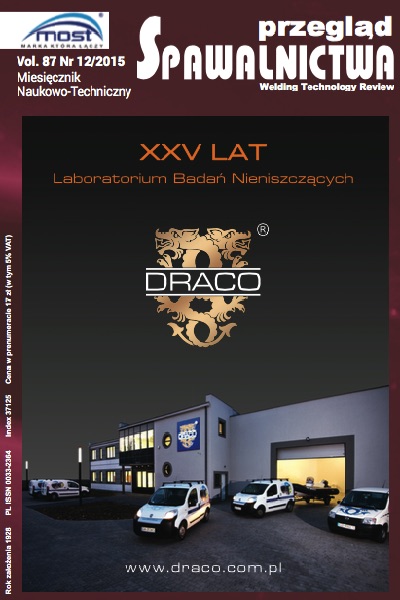Zastosowanie metody emisji akustycznej do lokalizacji uszkodzeń w zbiorniku na produkty ropopochodne
##plugins.themes.bootstrap3.article.main##
Abstrakt
W pracy przedstawiono zastosowanie metody emisji akustycznej do oceny stopnia uszkodzenia oraz lokalizacji miejsc o podwyższonym ryzyku dla bezpieczeństwa eksploatacji zbiorników niskociśnieniowych z podwójnym dnem stalowo-kompozytowym przeznaczonym na produkty ropopochodne. Sprawdzenia dokonano poprzez porównanie wyników miejsc wskazanych w badaniach metodą AT (acoustic testing) z odkrywkami dokonanymi podczas rewizji wewnętrznej. Budowa dna zbiornika oraz magazynowanie produktów uniemożliwiły przeprowadzenie inspekcji i ocenę stopnia uszkodzenia w trakcie eksploatacji. Dlatego też, zastosowanie metody AE daje możliwość dokładnej lokalizacji miejsc o podwyższonej intensywności sygnałów akustycznych bez potrzeby wyłączania obiektu z eksploatacji. Na podstawie pomiarów sygnałów AE można sporządzić wstępną ocenę stopnia uszkodzenia oraz kryteria AE. Badanie to pozwala na bezpieczną eksploatację bazy magazynowej jak również daje możliwość tworzenia harmonogramu oraz kosztorysu prac na poszczególnych zbiornikach.
Application of acoustic emission method
for damages location in the in petroleum products tank
Abstract
The paper presents the application of acoustic emission method to assess the degree of damage and the location of places of higher risk the safe operation of low-pressure tanks with a double bottom steel-composite. The check is done by comparing the results of the places specified in the study by AT outcrops made during the internal audit. Construction bottom of the tank and the storage of the products made it impossible to inspect and assess the extent of damage during operation. Therefore, the method of AT makes it possible the exact location of increased intensity of the acoustic signals without having to switch the object of use. Based on measurements of signals AT can make a preliminary assessment of the extent of damage and the criteria AT. This study allows for the safe operation of storage facilities as well as the ability to create schedule and cost estimate work on individual tanks.
Pobrania
##plugins.themes.bootstrap3.article.details##
Creative Commons CC BY 4.0 https://creativecommons.org/licenses/by/4.0/
Artykuły czasopisma Welding Technology Review (Przegląd Spawalnictwa) publikowane są w otwartym dostępie na licencji CC BY (licencja Creative Commons Uznanie autorstwa 4.0 Międzynarodowe). Licencja CC BY jest najbardziej otwartą dostępną licencją i uważaną za „złoty standard” w formule otwartego dostępu; jest również preferowany przez wielu fundatorów badań. Licencja ta umożliwia czytelnikom kopiowanie i redystrybucję materiału na dowolnym nośniku i w dowolnym formacie, a także zmienianie, przekształcanie lub budowanie na nim materiału, w tym do użytku komercyjnego, pod warunkiem wskazania oryginalnego autora.
Bibliografia
P. J. Van De Loo, D. A. Kronemeijer: Screening of tank bottom corrosion with a single point AE detector: AE- simple, Journal of Acoustic Emission, No 18 (2000), s. 174-180.
Świt G., Trąmpczyński W.: Preliminary classifification method of damage, of the tanks for petroleum products bottoms caused by corrosion, with use of acoustic emission, Proceedings of conference scien- tific-technical Steel Structures, Kielce Suchedniów, 2-4 July 2014, s. 155-158, Poland.
Goszczyńska B., Świt G., Trąmpczyński W.: Monitoring of active destructive processes as a diagnostic tool for the structure technical state evaluation, Bulletin of the Polish Academy of Sciences: Techni- cal Sciences, 61 (1), s. 97-109, 2013.
Goszczyńska B., Świt G., Trąmpczyński W.: Assessment of the technical state of large size steel structures under cyclic load with the acoustic emission method IADP, Journal of Theoretical and Applied Mechanics 52 (2), s. 289-299.
Goszczyńska B., Świt G., Trąmpczyński W., Krampikowska A.: Application of the acoustic emission (AE) method to bridge testing and diagnostics comparison of procedures, IEEE Xplore - IEEE Proceedings, s. 1-10, 2012, Bejiging, China.
Świt G.: Diagnostics of prestressed concrete structures by means of acoustic emission ICRMS Reliability, Maintainability and Safety, 2009. IEEE Xplore - IEEE Proceedings, s. 958-962, 2009, Chengdu, China.
